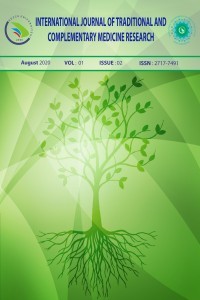The Effectivity of Prolotherapy Treatment in Shin Splint: A Randomized Controlled Study
The Effectivity of Prolotherapy Treatment in Shin Splint: A Randomized Controlled Study
Shin splints, athletic injuries, pain,
___
- 1. Willems T. Gait-related risk factors for exercise-related lower-leg pain during shod running. Med Sci Sports Exerc. 2007;39(2): 330–9.
- 2. Rome K, Handoll HHG, Ashford RL. Interventions for preventing and treating stress fractures and stress reactions of bone of the lower limbs in young adults (Review). Cochrane Database Syst Rev 2005;18(2).
- 3. Clement DB, Taunton JE, Smart GW, McNicol KL. A survey of overuse running injuries. Phys Sportsmed 1981;9:47-58.
- 4. Sharma J, Greeves JP, Byers M, Bennett AN, Spears IR. Musculoskeletal injuries in British Army recruits: a prospective study of diagnosis-specific incidence and rehabilitation times. BMC Musculoskelet Disord 2015;16:106. doi: 10.1186/s12891-015-0558-6.
- 5. Galbraith RM, Lavallee ME. Medial tibial stress syndrome: conservative treatment options. Curr Rev Musculoskelet Med 2009;2(3):127-133.
- 6. Beck B. Tibial stress injuries: an aetiological review for the purposes of guiding management. Sports Med 1998;26(4):265–79.
- 7. Anderson M, Ugalde V, Batt M, Gacayan J. Shin splints: MR appearance in a preliminary study. Radiology 1997;204:177–80.
- 8. Rabago D, Slattengren A, Zgierska A. Prolotherapy in primary care practice. Prim Care 2010;37:65-80.
- 9. Solmaz I, Orscelik A. Features and clinical effectiveness of the regenerative injection treatments: Prolotherapy and platelet-rich plasma for musculoskeletal pain management. In: From conventional to innovative approaches for pain treatment. 1 st ed. Intech Open Publishing Co; 2019.
- 10. Solmaz İ, Akpancar S, Örsçelik A, Yener-Karasimav Ö, Gül D. Dextrose injections for failed back surgery syndrome: a consecutive case series. Eur Spine J 2019;28(7):1610-7. doi: 10.1007/s00586-019-06011-3.
- 11. Citaker S, Kafa N, Hazar Kanik Z, Ugurlu M, Kafa B, Tuna Z. Translation, cross-cultural adaptation and validation of the Turkish version of the Lower Extremity Functional Scale on patients with knee injuries. Arch Orthop Trauma Surg 2016;136(3):389-95. doi: 10.1007/s00402-015-2384-6.
- 12. Bonanno DR, Murley GS, Munteanu SE, Landorf KB, Menz HB. Effectiveness of foot orthoses for the prevention of lower limb overuse injuries in naval recruits: a randomised controlled trial. Br J Sports Med 2018, 52(5):298-302.
- 13. Schulze C, Finze S, Bader R, Lison A. Treatment of medial tibial stress syndrome according to the fascial distortion model: a prospective case control study. ScientificWorldJournal 2014;2014:790626.
- 14. Korakakis V, Whiteley R, Tzavara A, Malliaropoulos N. The effectiveness of extracorporeal shockwave therapy in common lower limb conditions: a systematic review including quantification of patient-rated pain reduction. Br J Sports Med 2018;52(6):387-407. doi: 10.1136/bjsports-2016-097347.
- 15. Gomez Garcia S, Ramon Rona S, Gomez Tinoco MC, Benet Rodriguez M, Chaustre Ruiz DM, Cardenas Letrado FP, Lopez-Illescas Ruiz Á, Alarcon Garcia JM. Shockwave treatment for medial tibial stress syndrome in military cadets: A single-blind randomized controlled trial. Int J Surg 2017;46:102-9. doi: 10.1016/j.ijsu.2017.08.584.
- 16. Rabago D, Nourani B. Prolotherapy for Osteoarthritis and Tendinopathy: a Descriptive Review. Curr Rheumatol Rep 2017;19(6):34. doi: 10.1007/s11926-017-0659-3.
- 17. Örsçelık A, Seven MM, Yıldız Y. Prolotherapy Interventions in Treatment of Chronic Lateral Epicondylitis. Turk J Sports Med 2016;51(4):111-6.
- 18. Seven MM, Ersen O, Akpancar S, Ozkan H, Turkkan S, Yıldız Y, Koca K. Effectiveness of prolotherapy in the treatment of chronic rotator cuff lesions. Orthop Traumatol Surg Res 2017;103(3):427-33.
- 19. Ersen Ö, Koca K, Akpancar S, Seven MM, Akyıldız F, Yıldız Y, Ozkan H. A randomized-controlled trial of prolotherapy injections in the treatment of plantar fasciitis. Turk J Phys Med Rehabil 2017;64(1):59-65.
- 20. Apaydin AH, Örsçelik A, Yıldız Y. The effects of prolotherapy in recreational athletes with plantar fasciitis. Turk J Sports Med 2018;53(1):37-46.
- 21. Yıldız Y, Apaydin AH, Seven MM, Orscelik A. The effects of prolotherapy (hypertonic dextrose) in recreational athletes with patellofemoral pain syndrome. J Exp Integr Med 2016;6(2):53-6.
- 22. Fullerton BD. Prolotherapy for the Thoracolumbar Myofascial System. Phys Med Rehabil Clin N Am 2018;29(1):125-138.
- 23. Tsai SW, Hsu YJ, Lee MC, Huang HE, Huang CC, Tung YT. Effects of dextrose prolotherapy on contusion-induced muscle injuries in mice. Int J Med Sci 2018;15(11):1251-9. doi:10.7150/ijms.24170.
- 24. Akpancar S, Örsçelik A, Seven MM, Koca K. The effectiveness of prolotherapy on failed rotator cuff repair surgery. Turk J Phys Med Rehabil 2019;65(4):394-401.
- 25. Akpancar S, Gül D. Comparison of Platelet Rich Plasma and Prolotherapy in the Management of Osteochondral Lesions of the Talus: A Retrospective Cohort Study. Med Sci Monit 2019;25:5640-5647.
- ISSN: 2717-7491
- Yayın Aralığı: Yılda 3 Sayı
- Başlangıç: 2020
- Yayıncı: Düzce Üniversitesi
Ferit KAYA, Cahit POLAT, Birsen ADEMOĞLU, Furkan BAKİRHAN, Abdulkadir KANTARCIOĞLU, Ramazan GÜRGÖZE, Yavuz ORAK
Sabriye UÇAN YAMAÇ, Nurten TERKES
Effect of Body Acupuncture on Pregnancy-Related Low Back Pain and Pelvic Pain: A Systematic Review
Nafiye DUTUCU, Ayça ŞOLT, Sena Dilek AKSOY
The Effectivity of Prolotherapy Treatment in Shin Splint: A Randomized Controlled Study
İlker SOLMAZ, Aydan ÖRSÇELİK, Serkan AKPANCAR, Mehmet Murat SEVEN
Sefa Haktan HATIK, Demet TEKİN, Korhan Barış BAYRAM
Toxicological Evaluation of Aqueous Stem Bark Extract of Guiera senegalensis on Wistar Rats
Maryam Usman AHMED, Diowato TİTUS, Isaac John UMARU
